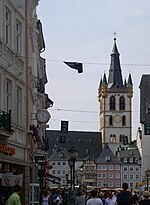Basilica of St. Paulinus, Trier
Basilica churches in GermanyRoman Catholic churches in Trier

Saint Paulinus (German: St. Paulinskirche) is a Baroque church in the city of Trier, Germany. Constructed between 1734 and 1753, the interior was designed by Johann Balthasar Neumann. The ceiling of the nave features a painting by the artist Christoph Thomas Scheffler. The tomb of the saint after whom the church is named, Paulinus of Trier, is located in the church's crypt. Based in Germany's oldest city with a significant Roman history, three church buildings have stood on the site since the 4th century.
Excerpt from the Wikipedia article Basilica of St. Paulinus, Trier (License: CC BY-SA 3.0, Authors, Images).Basilica of St. Paulinus, Trier
Thebäerstraße, Trier Nord (Nord)
Geographical coordinates (GPS) Address Website External links Nearby Places Show on map
Geographical coordinates (GPS)
| Latitude | Longitude |
|---|---|
| N 49.7625 ° | E 6.6522222222222 ° |
Address
St. Paulin
Thebäerstraße 54
54292 Trier, Nord (Nord)
Rhineland-Palatinate, Germany
Open on Google Maps










